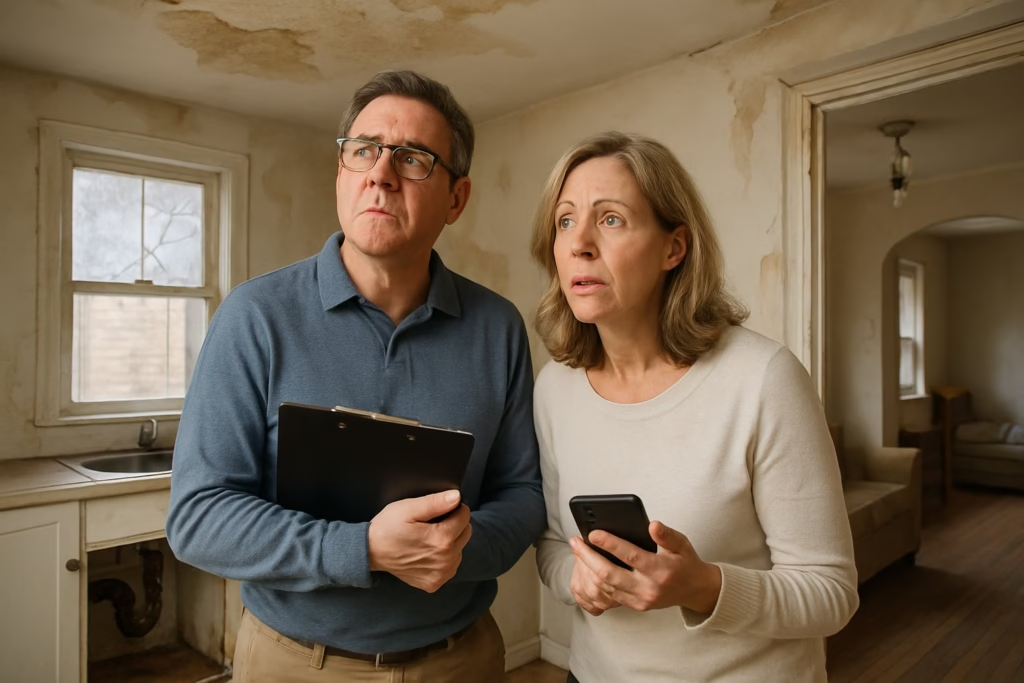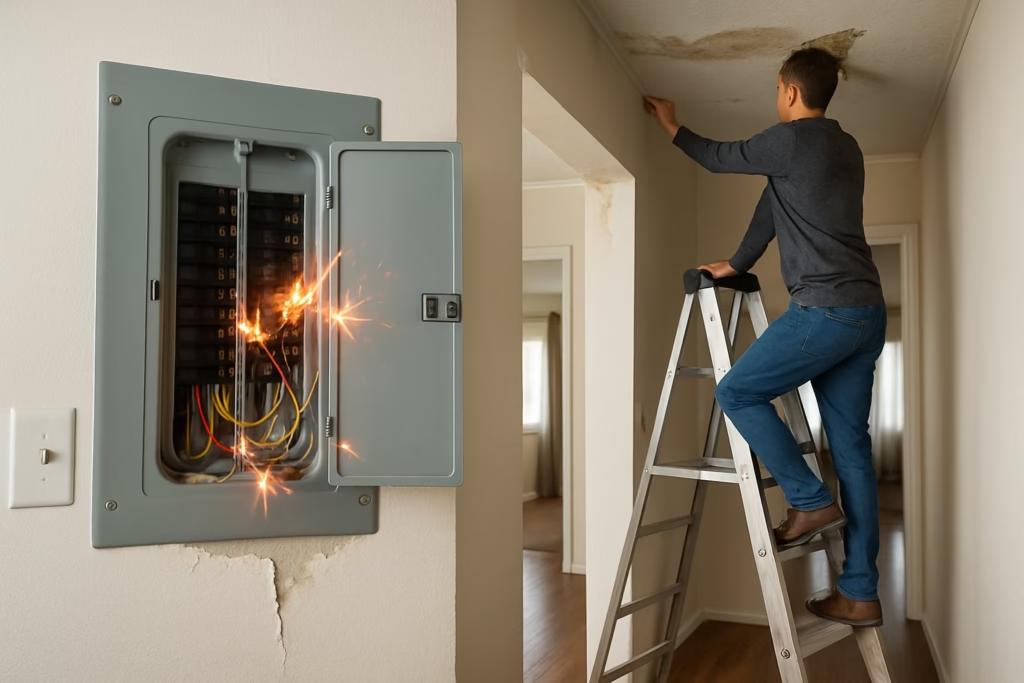Most homeowners put off small repairs thinking it’ll save money for now. A flickering light switch or loose floorboard? Easy to ignore until next month, or maybe even next year.
But honestly, delaying home repairs often ends up costing a lot more and leads to bigger headaches than just fixing things right away.

Small problems don’t stay small for long. A tiny roof leak? It can quickly turn into major water damage all over your house.
Hidden costs sneak in—higher repair bills, safety risks, lower home value, insurance headaches, and structural damage that just gets worse the longer you wait.
1) Increased Repair Costs Due to Escalating Damage

Small problems can balloon into big expenses fast if you don’t fix them right away. What starts as something minor often turns into a disaster that costs way more to repair.
Take a little water leak. At first, you might just need a pipe fix. Wait too long, and now you’ve got water soaking your walls, floors, maybe even your wiring.
Some studies say ignoring leaks can drive up repair costs by 500% over time. The longer you wait, the more the damage creeps through your house.
Electrical problems? Same story. A flickering light might just need a new switch. Ignore it, and you could face serious wiring damage that costs thousands.
Roof issues love to snowball too. A couple missing shingles might be a $200 fix. Wait, and water damage could mean a full roof replacement—think $15,000 or more.
Catch problems early if you can. Quick fixes now save you from those wallet-busting emergencies down the road.
2) Safety Hazards Like Electrical Fires and Falling Injuries

Delaying repairs can put your family in real danger. Electrical issues alone cause about 46,000 house fires a year in the U.S.
Those fires kill around 440 people and injure over 1,200. Property damage racks up to $1.5 billion each year. That’s a lot of risk for something that often starts small.
Faulty wiring, damaged cords, and overloaded outlets are all fire hazards. Frayed cords expose live wires that can spark up without warning.
Nearly half of all home electrical fires involve bad cords and plugs. If you put off repairs, you’ll likely pay double for fixes later. And DIY jobs gone wrong? Usually means an electrician has to redo everything.
Structural repairs you skip can also lead to falls. Loose handrails, broken steps, and damaged floors are just asking for accidents.
Water from roof leaks can weaken floors and ceilings. That creates real collapse risks—and nobody wants that kind of surprise.
What starts as a minor issue can quickly become a serious safety threat if you ignore it.
3) Reduced Home Resale Value from Visible Defects
Buyers size up your home within minutes of stepping inside. Any visible defect screams neglect and bad maintenance.
Roof stains? They catch eyes fast. Water marks on ceilings make buyers think “leaks” and worry about what else is lurking.
Cracked paint or peeling siding just looks sloppy. People see these and assume bigger problems are hiding somewhere.
Broken windows and busted trim don’t help either. Spending $200 on a quick fix now can save you thousands in home value later.
Buyers bring inspectors who spot everything. Visible flaws give them ammo to push for lower prices or walk away.
Your competition probably has well-maintained homes. If yours looks neglected, it’ll sit on the market longer.
Real estate agents know obvious defects scare off serious buyers. Some folks won’t even bother making an offer if your place looks rough.
Putting some cash into repairs before selling? It protects your investment and helps your home sell faster—and for more.
4) Higher Insurance Premiums and Claim Risks
Skip repairs and your insurance costs might creep up. Insurers see poorly maintained homes as bigger risks—so, higher premiums for you.
Delay fixes and your rates could jump. Companies charge more if they think you’re likely to have a claim.
Some homeowners avoid filing claims because they’re worried about inspections. Actually, about 1 in 4 skip claims entirely.
But that plan can backfire. If you don’t report damage, small issues can quietly grow into expensive problems.
Insurance companies keep claim records for seven years. If they see a pattern of neglect, you might get hit with even higher rates or lose your policy altogether.
Well-maintained homes get better coverage and prices. If you let repairs slide, you face stricter rules and more expensive premiums.
File too many claims and you raise red flags. Your premiums could jump 10% to 40%, or your insurer might drop you.
Staying on top of maintenance helps you dodge both small claims and big disasters.
5) Structural Integrity Compromises Over Time
When you put off repairs, your home’s structure slowly weakens. Small issues have a way of growing into serious threats to the whole building.
Water leaks are especially nasty. They damage wooden beams and metal supports, and over time, those lose their strength.
Foundation problems often start tiny but get worse fast. Cracks let in more water, which just speeds up the damage.
Floor joists can shift when water weakens them. Suddenly, your home’s balance is off and safety becomes a real concern.
Support beams can’t hold weight like they used to. What started as a little water issue can end up making your whole house unstable.
The longer you wait, the pricier the fix. Simple repairs turn into massive construction jobs that cost a fortune.
Weakened floors, walls, and ceilings can fail without warning. That’s a risk nobody wants at home.
Professional inspections can catch these problems early. Jumping on repairs quickly keeps small issues from turning into disasters.
Understanding the True Cost of Postponed Repairs
Delay home repairs and you’ll watch small problems snowball into major expenses—sometimes 3 to 10 times what the original fix would cost. A $200 roof leak repair? Ignore it, and you might be staring down a $5,000 structural damage bill in a few months.
How Minor Issues Escalate Over Time
Little repairs follow a pretty predictable path. A loose shingle lets water sneak into your roof deck. That moisture leads to wood rot and mold before you know it.
What should’ve been a $150 shingle replacement can become a $3,000 roof rebuild. Water damage spreads to insulation and ceilings, making things even worse.
Common escalation examples:
- Dripping faucet ($50 fix) → Water damage and mold ($2,500 remediation)
- Cracked foundation ($300 seal) → Structural settlement ($8,000 repair)
- Clogged gutter ($75 cleaning) → Foundation water damage ($4,000 fix)
Temperature swings make it worse. Summer heat expands materials, winter cold contracts them—cracks widen, connections loosen.
Pest entry points just get bigger with time. A small gap can turn into a major infestation route if you let it go.
Link Between Delays and Increased Expenses
Repair costs don’t just creep up—they explode over time. Some studies say home repair costs double every 6 to 12 months if you ignore them.
Emergency repairs are always pricier than planned maintenance. Need help on a weekend or holiday? Expect premium charges on top.
Cost multiplication factors:
| Original Issue | 6 Months Later | 2 Years Later |
|---|---|---|
| $200 | $400-600 | $1,200-2,000 |
| $500 | $1,000-1,500 | $3,000-5,000 |
Secondary damage drives up your bill. A leaky pipe doesn’t just need fixing—it ruins floors, walls, maybe even your wiring. Suddenly, you’re paying for several repairs instead of one.
Insurance coverage drops off when you delay. Most policies exclude damage from neglected maintenance, so you’ll pay a lot more out of pocket.
Material costs keep rising, too. Supply chain issues and inflation mean waiting six months could add 15-25% to your repair bill.
Long-Term Impact on Home Value and Insurance
Delaying repairs doesn’t just hurt your wallet now—it drags down your home’s value and can mess with your insurance, too. Buyers spot maintenance issues fast, and insurers might deny claims or cut coverage for neglected properties.
Factors That Affect Resale Value
Buyers notice problems right away during inspections. Roof stains, uneven floors, and moisture readings set off alarm bells and can kill deals instantly.
Water damage from putting off repairs can knock $10,000 to $20,000 off your resale value. A $1,500 fix today? It can save you from that kind of hit.
Structural issues are the worst for your home’s value. Foundation cracks, leaks, and electrical problems make buyers walk or demand huge discounts.
Visual stuff matters, too. Peeling paint, broken windows, damaged siding—they all make buyers think you’ve skipped other maintenance.
Key value-killing issues include:
- Foundation settling or cracks
- Roof damage or missing shingles
- Plumbing leaks or water stains
- Electrical code violations
- HVAC system failures
Real estate agents say homes with obvious maintenance issues sit on the market 30 to 60 days longer than well-kept ones.
Insurance Coverage Limitations Due to Neglect
Insurance companies dig into claims and often deny coverage if damage comes from neglect. They expect you to keep your place in decent shape.
Gradual damage from ignoring problems gets rejected the most—think slow leaks, foundation settling, or old pipes wearing out.
Your policy requires you to prevent further damage once you spot a problem. Ignore a roof leak that turns into major water damage? Your coverage probably won’t help.
Common coverage denials include:
- Mold from ignored water leaks
- Structural damage from foundation issues
- Electrical fires from old wiring
- Burst pipes from poor maintenance
Some insurers now want maintenance inspections before renewing policies. If they find deferred repairs, you might get lower coverage or higher deductibles.
File too many claims for preventable issues and your policy could get canceled. Then finding new coverage gets tricky—and way more expensive.
Frequently Asked Questions
Homeowners always seem to have questions about how repair delays can mess with their budgets. Even tiny issues—like a drip in the pipes or a weird noise in the HVAC—can snowball into wallet-busting disasters if you ignore them.
How can postponing roof repairs lead to higher expenses over time?
Let’s say you spot a small roof leak. Fixing it right away might run you about $300. But if you wait, water starts creeping into your ceiling, walls, and insulation.
Suddenly, you’re staring at a $5,000 repair bill, maybe more. And where there’s moisture, mold isn’t far behind.
Mold removal can tack on another $2,000 to $6,000. Plus, water stains and damage make your home less appealing to buyers during inspections.
What potential costs can arise from neglecting plumbing maintenance?
Ignore a tiny pipe leak and you’ll waste hundreds of gallons of water every month. That waste shows up on your utility bill until you finally get it fixed.
Water damage from leaks can ruin your floors, walls, and even your favorite couch. Swapping out damaged flooring? That’ll cost you $3 to $12 per square foot.
Let pipes corrode too long and they’ll burst, flooding your place. Emergency plumbing repairs usually cost double or triple what you’d pay for regular maintenance.
Why can deferring electrical work escalate overall home repair costs?
Flickering lights or blown fuses might seem harmless, but they often point to bigger electrical issues. Faulty wiring can overheat and spark house fires before you know it.
If that happens, fire damage restoration might run into the tens of thousands. And after an electrical fire, your insurance company probably won’t cut you any slack on premiums.
Old electrical systems also struggle with modern appliances. Instead of a quick fix, you might end up rewiring the whole house.
In what ways do delayed foundation repairs increase homeowners’ financial burden?
Even small cracks in your foundation let water sneak into your basement or crawl space. That moisture can rot the wooden beams holding up your home.
As your foundation settles, doors and windows start sticking or warping. You’ll end up replacing those too, not just fixing the foundation.
Major foundation repairs can set you back $10,000 to $40,000. Sealing cracks early? That’s only $500 to $1,500.
How do unaddressed HVAC issues result in unexpected costs?
Dirty air filters force your HVAC to work overtime, burning more energy. That bumps up your utility bill by 10 to 15 percent—easy to overlook, but it adds up.
Skip maintenance and your system will break down more often. Emergency calls cost $200 to $500 more than a regular tune-up.
If you keep putting off service, your HVAC might only last 8 years instead of 15. Replacing the whole system? Prepare to drop $5,000 to $12,000.
Can ignoring routine home maintenance lead to compounded structural problems?
Absolutely. Even small maintenance issues can start a chain reaction throughout your home.
Take a clogged gutter, for example—it doesn’t just sit there. It can wreck your roof, siding, and even your foundation all at once.
When that kind of interconnected damage happens, you end up calling in multiple contractors. The repair bills? They add up fast.
It’s almost always pricier to fix everything at once than to tackle each problem as it pops up.
Your home’s structural integrity takes a real hit when several systems fail together. Sometimes, these combined problems can actually make your home unsafe.
